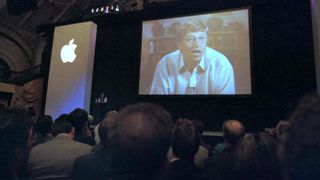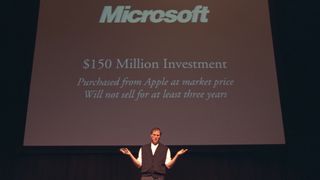On the eve of yet another Apple event, one in which it introduces a collection of iPhone 16 handsets probably not hugely different from the year before, and the collective technology consumer leaps into buying action because, well, it’s Apple, it’s worth remembering that, perhaps, none of this would’ve been possible without an act of charity or calculation by Apple’s once greatest rival: Microsoft.
I was reminded of the era when Apple, its heyday in the rearview, was relegated to failed Newton Handhelds, poorly conceived partnerships with Bandai (Pippin game console/internet appliance), and near irrelevance.
In the years after Apple co-founder and CEO Steve Jobs was ousted and his return in early 1997, Apple watched its revenues tumble from a high of $11 billion to $7 billion. It saw its losses mounting to $125M in 1996. There was talk of a merger with Sun Microsystems, one that then Apple CEO Gilbert Amelio wouldn’t confirm and that spokespeople denied. It was clear though that such talk was further hampering sales of Apple’s then mostly lackluster Power Macintoshes and Powerbooks.
While there’s some disagreement on the level of Apple’s red ink at the time, even Jobs admitted just months after his return that there was work to do “to make Apple healthy again.” It was during that memorable Macworld 1997 presentation that Jobs outlined a plan to bring Apple back. Notably, there wasn’t a single new product announcement; this was all about new leadership, new, partnerships, and a cash infusion from Apple’s biggest rival.
What people remember about that day is that Microsoft committed to buying $150M Apple shares (non-voting).
The price of survival

“Yes but the important part of this that did not get enough attention is that this included an open-ended license for Microsoft to use a graphical interface for Windows,” longtime Apple analyst and Creative Strategies chairman Tim Bajarin told me. Bajarin has been covering Apple almost since its inception.
People like Bajarin, who knew Jobs and the sorry state of the company, cheered the bailout (“it was a good and strategic win for both”), but not those in attendance at Macworld.
They booed the stock buy and other elements of the landmark deal (Microsoft promising to release MS Office for Mac for the next 5 years got a more positive response). When Jobs explained that Apple had agreed to make Internet Explorer the default web browser for Mac, an attendee cried out, “No!”
The reaction was understandable. Apple’s business was built on an anti-PC foundation, the opposite of Microsoft’s Windows and its more corporate worldview. The antagonism once appeared to fuel both companies. But those days were long gone. As Jobs noted in his presentation, “Relationships that are destructive don’t help anyone in this industry as it is today.”
Of course, Microsoft was not being entirely altruistic. As part of the deal, Apple agreed to a broad patent settlement and cross-license deal “for all patents, including those filed in the next five years.” This meant Apple would not go after Microsoft for its use of a too-similar-to-Mac OS GUI interface on any version of Windows.
Putting Internet Explorer on yet another platform helped Microsoft cement its rapidly growing lead in the web browser space. I’m not sure that move helped it when it faced an antitrust suit in 2000.
Within a year, the value of Microsoft’s investment virtually doubled and only grew from there.
A deed that paid off

While the reasons for Apple’s fall from grace were myriad (Jobs described it as “executing wonderfully on many of the wrong things”), there was reason to believe that the brand could be not just strong, but a potential powerhouse. During his presentation, Jobs described incredible brand recognition and its enviable market position in education and creative content.
In 1997, 64% of all websites were, according to Jobs, being designed on a Mac and 60% of all computers in education were Macs. The numbers are all the more surprising because, by Apple’s own count, it had about 20M customers. Today the company has over 2 billion.
What Apple lacked for more than a decade, though, was its founder and visionary. Jobs came with ideas (and the remnants of the NeXT platform). Bajarin believes the cash infusion gave Apple time to develop the iconic iMac, which shipped in August 1998.
Of course, it gave us far more than that. One could argue that without Microsoft’s $150M life preserver, Apple might not have survived. It’s possible then that there’d be
- No iPod
- No iPhone
- No iPad
- No Apple Watch
- You get the idea
I can’t argue that we would not have gotten there eventually, but the mobile computing revolution might’ve been delayed by five or more years.
Think about it, it only took $150M to save a company that would change our lives and eventually be worth trillions.
So, when you’re marveling over the latest iPhone 16, AirPods Pros, and Apple Watches, raise a glass to Microsoft and, yes Bill Gates, who was heartily booed when he appeared on screen at that 1997 Macworld. Without them, the Apple of 2024 might not even exist.
You might also like
Services Marketplace – Listings, Bookings & Reviews
